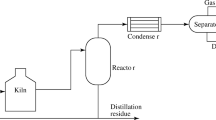Results are given for a study on the optimization of the composition of crude oil consisting of petroleum, fuel oil, and gas condensate to improve atmospheric distillation at an installation of the Gazprom Neftekhim Salavat Atmospheric and Vacuum Distillation Company. The results of a determination of the size of dispersed phase particles and the stability factor were used to predict the effect of the gas condensate in the crude oil on the major physicochemical properties and yield of light petroleum products. An active state of the dispersed system in the mixed crude oil was found at 40 wt.%. Atmospheric distillation of the activated crude oil permits an increase in the yield of light petroleum products by 28 wt. %.




Similar content being viewed by others
References
S. A. Akhmetov, Technology of Deep Petroleum Refining [in Russian], Nedra, St. Petersburg (2013).
T. V. Bukharkina, S. V. Verzhichinskaya, N. G. Digurov, et al., Petroleum Refining: Theoretical and Technological Aspects [in Russian], Tekhnika, Moscow (2012).
P. A. Rebinder, Surface Phenomena in Dispersed Systems [in Russian], Nauka, Moscow (1978).
B. P. Tumanyan, Scientific and Applied Aspects of the Theory of Oil Dispersed Systems [in Russian], Tekhnika, Moscow (2000).
G. I. Fuks, Colloidal Chemistry, of Petroleum and Petroleum Products [in Russian], Znanie, Moscow (1984).
R. Z. Safieva, Physical Chemistry of Petroleum. Physicochemical Basis of the Technology of Petroleum Refining [in Russian], Khimiya, Moscow (1998).
Z. N. Syunyaev, R. Z. Safieva, and R. I. Syunyaev, Oil Dispersed Systems [in Russian], Khimiya, Moscow (1990).
N. G. Evdokimova, E. V. Gryzina, E. A. Yalieva, et al., Neftegazovoe Delo, No.5, 323-335 (2011).
N. G. Evdokimova, Development of the Scientific and Technological Fundamentals of the Production of Modern Butiminous Materials as Oil Dispersed Systems [in Russian], Technological Sciences Doctoral Dissertation, Moscow (2015).
E. V. Komarova, N. G. Evdokimova, and M. R. Mardanova, Neftegazovoe Delo, 11, No.4, 141-144 (2013).
N. G. Evdokimova, O. B. Prozorova, and K. V. Kortyanovich, Methods in the Study of Bitumens and Petroleum Residues [in Russian], Ufa State Petroleum Technological University, Ufa, Russia (2004).
L. P. Gilyazetdinov and M. A1’-Dzhomaa, Khimiya i Tekhnologiya Topliv i Masel, No. 3, 27-29 (1994).
Author information
Authors and Affiliations
Corresponding author
Additional information
Translated from Khimiya i Tekhnologiya Topliv i Masel, No. 3, pp. 37 — 39, May — June, 2019.
Rights and permissions
About this article
Cite this article
Evdokimova, N.G., Vorob’eva, A.I. & Luneva, N.N. Optimal Composition of Crude Oil for Atmospheric Petroleum Distillation. Chem Technol Fuels Oils 55, 266–271 (2019). https://doi.org/10.1007/s10553-019-01029-1
Published:
Issue Date:
DOI: https://doi.org/10.1007/s10553-019-01029-1



